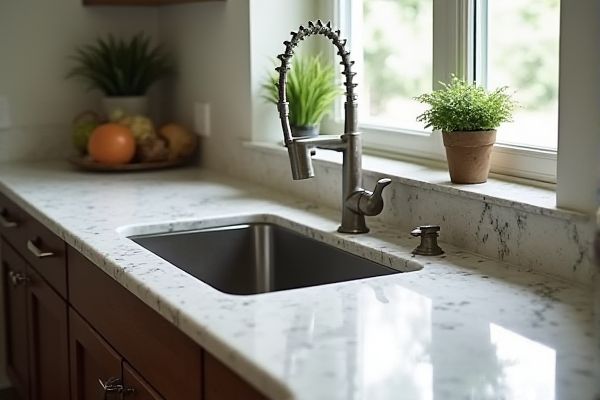
A double-bowl sink offers versatile functionality for multitasking, allowing you to wash dishes in one basin while rinsing or soaking in the other, making it ideal for busy kitchens. Explore the rest of the article to discover which sink type best fits your cooking and cleaning needs.
Table of Comparison
| Feature | Double-Bowl Sink | Single-Bowl Sink |
|---|---|---|
| Design | Two separate basins | One large basin |
| Functionality | Separate tasks (washing and rinsing) | More space for large pots and pans |
| Installation Space | Requires more countertop space | Requires less countertop space |
| Cleaning Convenience | Separate waste and soaking areas | Simple, easy to clean |
| Price Range | Moderate to high | Low to moderate |
| Best For | Multi-tasking kitchens | Small or compact kitchens |
Overview of Double-Bowl and Single-Bowl Sinks
Double-bowl sinks feature two separate basins, allowing for multitasking such as washing dishes in one bowl while rinsing in the other, enhancing kitchen workflow and organization. Single-bowl sinks provide a larger, uninterrupted basin ideal for washing large pots and pans, offering simplicity and maximum space efficiency. Choosing between the two depends on kitchen size, usage habits, and cleaning preferences, with double-bowl sinks favored for multitasking and single-bowl sinks preferred for space and versatility.
Pros and Cons of Double-Bowl Sinks
Double-bowl sinks offer enhanced multitasking abilities, allowing You to wash dishes on one side while rinsing or drying on the other, improving kitchen efficiency. They provide organizational advantages but often require more counter space and can be harder to clean due to crevices between bowls. This sink type suits busy kitchens but may not be ideal for compact spaces where single-bowl sinks maximize surface area for washing larger items.
Advantages and Disadvantages of Single-Bowl Sinks
Single-bowl sinks offer a spacious basin that accommodates large pots and pans, making kitchen tasks like washing and rinsing more efficient. They require less counter space and are easier to clean due to their simple design, but their lack of compartments can limit multitasking during meal preparation. If your kitchen workflow prioritizes simplicity and maximum basin space, a single-bowl sink could be the ideal choice for your needs.
Space and Size Considerations
Double-bowl sinks offer enhanced functionality by dividing the workspace, making them ideal for multitasking in kitchens with ample counter space. Single-bowl sinks provide a larger continuous basin, better suited for washing large pots and pans in smaller or compact kitchen layouts. Evaluating available counter space and kitchen workflow helps determine the optimal size and configuration for efficient use.
Kitchen Workflow and Functionality
Double-bowl sinks enhance kitchen workflow by allowing simultaneous tasks such as washing dishes in one basin while rinsing vegetables in the other, increasing efficiency and reducing cross-contamination. Single-bowl sinks offer more space for larger pots and pans but may require more time juggling multiple tasks, potentially slowing down your kitchen functionality. Choosing the right sink depends on your cooking habits and the need for multitasking in your kitchen environment.
Cleaning and Maintenance Differences
Double-bowl sinks offer greater flexibility in cleaning tasks by allowing simultaneous washing and rinsing or separating delicate items from heavy-duty scrubbing. Single-bowl sinks provide a larger uninterrupted space that simplifies washing large pots and pans but may require more careful water management to avoid messes. Maintenance for double-bowl sinks can be slightly more complex due to extra seams and fittings, whereas single-bowl sinks typically require less upkeep with fewer crevices that harbor grime.
Installation Requirements and Costs
Double-bowl sinks demand more complex installation due to additional plumbing connections and larger countertop cutouts, often leading to higher labor costs. Single-bowl sinks generally require simpler installation with fewer plumbing modifications, resulting in lower initial expenses. Assess your kitchen's existing plumbing and budget to determine which sink aligns best with your installation requirements and cost considerations.
Material and Design Options
Double-bowl sinks offer versatile material choices like stainless steel, fireclay, and granite composite, providing durability and style options to match varied kitchen aesthetics. Single-bowl sinks often come in larger sizes with fewer design variations but excel in accommodating oversized pots and pans, made from materials like stainless steel, porcelain, or quartz composite. Your choice between double-bowl and single-bowl should consider the balance between functionality and the material finish that complements your kitchen design.
Suitability for Different Kitchen Styles
Double-bowl sinks offer versatile functionality ideal for busy kitchens, providing separate spaces for washing and rinsing, and suit traditional or farmhouse styles that emphasize practicality and multitasking. Single-bowl sinks, with their spacious, uninterrupted basin, complement modern and minimalist kitchen designs focused on sleek aesthetics and streamlined workflows. Your choice depends on whether you prioritize multitasking convenience or a clean, uncluttered look in your kitchen space.
Which Sink Type Is Best for Your Kitchen?
Choosing between a double-bowl sink and a single-bowl sink depends on your kitchen workflow and space requirements; double-bowl sinks offer versatility for multitasking like washing and rinsing simultaneously, while single-bowl sinks provide a larger uninterrupted space ideal for washing bulky pots and pans. Your kitchen size and dishwashing habits play crucial roles in this decision, with double-bowl sinks best suited for multitasking efficiency and single-bowl sinks preferred for simplifying cleanup and maximizing basin space. Considering these factors helps you select the sink type that enhances both functionality and convenience in your kitchen.
 homyna.com
homyna.com